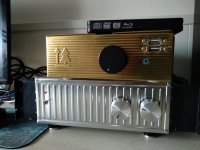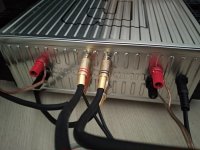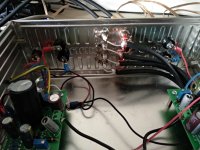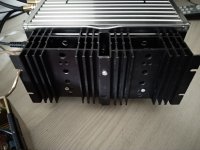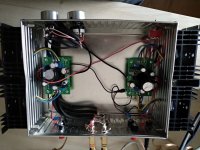Member
Joined 2009
Paid Member
The trouble is, not all 2N3055's are the same. The version I have been using has an 'H' appended to the end of the part number and together with their age and manufacturer tells me these are slow parts with an ft of 800 kHz. Plenty fast enough open loop but in a feedback amp not idea. Furthermore, I had a lot of them, all riveted on the heatsink that I recovered from a power supply in the w-waste. I insisted on using them all in parallel because it 'felt right' and so I have an awful lot of 'input' capacitance for the output stage which the poor driver device is trying to swing up and down. Contrary to folklore BJTs do have plenty of capacitance to drive (like MOSFETs) and in the JLH topology the 'lower' output power devices are in common emitter not emitter follower which doesn't help.
Morris Dancing - I have been unable to bring myself to dress in bells and dance around. Fortunately, I've had my children so no need to enter into ancient fertility dances. Nevertheless, I'm a big fan of tradition, there's nothing quite as enjoyable as watching a village cricket match, a Morris Dance and attending a church fete, and following them in to the local pub for a pint of the golden nectar.
Morris Dancing - I have been unable to bring myself to dress in bells and dance around. Fortunately, I've had my children so no need to enter into ancient fertility dances. Nevertheless, I'm a big fan of tradition, there's nothing quite as enjoyable as watching a village cricket match, a Morris Dance and attending a church fete, and following them in to the local pub for a pint of the golden nectar.
I think I'd sum the 2N3055s up as "quite good enough" rather than very good. They are, after all, an anachronism now and as Big'n said, they are not all the same. The real reasons for choosing them are because they are very cheap, ubiquitous and still manage to look substantial.
If you have the cash to lavish on your creation, try some really excellent 4MHz transistors like On-Semi's MJ21194 or the plastic version MJL21194. I found this to be an interesting experiment, learning at the same time that lower distortion doesn't necessarily translate to better sound quality and enjoyment. Funny, that.
If you have the cash to lavish on your creation, try some really excellent 4MHz transistors like On-Semi's MJ21194 or the plastic version MJL21194. I found this to be an interesting experiment, learning at the same time that lower distortion doesn't necessarily translate to better sound quality and enjoyment. Funny, that.
I suspect genuine 2N 3055 no longer exist. What does exist is something very similar in a T03 case. I find the current gain is higher and no doubt bandwidth. MJ 15015 is listed with 3055. I suspect that the 3055AG is a drop out voltage spec version. of 15015. As said before in an amplifier like this it's current gain that matters. Higher current gain goes hand in hand with wide bandwidth. If the JLH could be made class AB it most likely would be a poor quality design. It just wouldn't have enough speed to suppress crossover distortion. As it's class A it side steps all the usual problems. Tip3055 which I am told isn't a 3055. might be what is now used..Tip35C looks good.
Good morning Ian,
Thanks for the message good of you and thanks for the MJ21194 suggestion. I did have a look for them and Cricklewood do sell them (sharp intake of breath) 4 would be more than I spent on the two amplifier boards and the TIP3055's.
I'm quite enjoying my switched subjective test JLH vs 3886 I should finish that by the weekend. It would be very interesting to do the same with MJ21194 vs TIP3055. It's one of the reasons I use large wooden boxes, it being easier to do this. My chip amps are made on wooden sub assemblies for the same reason.
I often wonder when people show some cramped titchy metal boxed creation and then say it's much better than their previous effort, from errrrr well memory! LoL.
Cheers
[edit] morning Nigel, TIP35c looked that up on Cricklewood too, 3 for the price of one MJ21194, (4th one free?)
Thanks for the message good of you and thanks for the MJ21194 suggestion. I did have a look for them and Cricklewood do sell them (sharp intake of breath) 4 would be more than I spent on the two amplifier boards and the TIP3055's.
I'm quite enjoying my switched subjective test JLH vs 3886 I should finish that by the weekend. It would be very interesting to do the same with MJ21194 vs TIP3055. It's one of the reasons I use large wooden boxes, it being easier to do this. My chip amps are made on wooden sub assemblies for the same reason.
I often wonder when people show some cramped titchy metal boxed creation and then say it's much better than their previous effort, from errrrr well memory! LoL.
Cheers
[edit] morning Nigel, TIP35c looked that up on Cricklewood too, 3 for the price of one MJ21194, (4th one free?)
Last edited:
I noticed MJ15016 PNP a better device. This may make an inverse PNP JLH worth trying.
The TIP35C is good value. Cricklewood still have BDY56. That's a nice device. Early Naim NAP250/160.
The TIP35C is good value. Cricklewood still have BDY56. That's a nice device. Early Naim NAP250/160.
Power transistor prices relate to the production run quantities and the high cost to process them for good gain v current linearity. Flat is ideal but real world transistors need lots of feedback to compensate for their sagging curves (a bit like us older folk). Even so, it still requires some amazing transistor manufacturing tricks to even approximate a linear audio current transfer from the power supply to the speakers.
That's what we need for ultimate hi-fi but perhaps we'd be just as happy with something less. Considering how poorly some commercial amplifiers perform, Maybe the 2N3055/TIP3055 types really are good enough for DIY - at least up to moderate levels.
That's what we need for ultimate hi-fi but perhaps we'd be just as happy with something less. Considering how poorly some commercial amplifiers perform, Maybe the 2N3055/TIP3055 types really are good enough for DIY - at least up to moderate levels.
I often wonder when people show some cramped titchy metal boxed creation and then say it's much better than their previous effort, from errrrr well memory! LoL.
Maybe it did not occur to you but people may use a new metal casing for every device they build and then can compare without any issue. LOL 🙂
The wooden casings you described may not have the best shielding properties when compared to those cramped titchy metal boxed creations.
Last edited:
Hello Jean-Paul,
I've been making amplifier boxes from timber for 23 years. I have never experienced any interference. I make them large so I can easily alter components.
The comparisons, I've read 100's of them, they never say they changed internal components to be able to switch between speakers in mono, or even used switches to hear immediate differences between two amplifiers. I also know why, too idle to do it properly Lol 🙂
They are all based on memory, which in my opinion is a complete waste of everyone's time. Please read Mr Hoods original 1969 article to see what he did it's on pages 152/ 153
You may download it here: JLH 1969 Original Article.pdf - Google Drive
Cheers
I've been making amplifier boxes from timber for 23 years. I have never experienced any interference. I make them large so I can easily alter components.
The comparisons, I've read 100's of them, they never say they changed internal components to be able to switch between speakers in mono, or even used switches to hear immediate differences between two amplifiers. I also know why, too idle to do it properly Lol 🙂
They are all based on memory, which in my opinion is a complete waste of everyone's time. Please read Mr Hoods original 1969 article to see what he did it's on pages 152/ 153
You may download it here: JLH 1969 Original Article.pdf - Google Drive
Cheers
Usually speaking as current amplifiers transistors of any type are quite good. I estimated the open loop distortion of the JLH 2N3055 as 8%. I think John had 3% THD on simulation. It is surprising how good the close loop distortion is. It would be interesting if a simulation of a 3055 and a 30 MHz device was compared. If I understand the JLH correctly the distortion is a complex mix of voltage amplifier with feedback and a current amplifier. I probably would use a BD139 as driver and assume a gain of 100. That should emphasize the superiority of the 30 MHz device having better gain. It should also have better linearity. My guess is it won't be a vast difference. I am happy to be wrong as that's the point. We learn by asking questions.
Hello Jean-Paul,
I've been making amplifier boxes from timber for 23 years. I have never experienced any interference. I make them large so I can easily alter components.
The comparisons, I've read 100's of them, they never say they changed internal components to be able to switch between speakers in mono, or even used switches to hear immediate differences between two amplifiers. I also know why, too idle to do it properly Lol 🙂
They are all based on memory, which in my opinion is a complete waste of everyone's time. Please read Mr Hoods original 1969 article to see what he did it's on pages 152/ 153
You may download it here: JLH 1969 Original Article.pdf - Google Drive
Cheers
First it depends what you call interference. Not everything can be heard as interference. In this day and age metal boxes or shielding are almost mandatory.
Second you spoke in a negative way of others doing comparisons the inappropriate way so I gave the example of people building 2 devices that can de compared directly. So IMO you are in the area of assumptions. Many here build as much as they can and deliver stunning looking device after device. To me this is very inspirational and it challenges me to deliver better devices. Yes that really is a waste of time but it is a pastime. After having built quite a few good looking and good performing linear power supplies I realised that I could have bought one of the best for less 😀
There is nothing wrong building stuff in small stylish looking metal boxes that also serve as shielding and to build several devices. In fact it is the hard way as it needs careful planning and careful metal work to be functional, safe and good looking. To use one casing made of timber is the easy way.
Next thing is that you declare the use of PCBs unnecessary !?
Last edited:
Hello Jean-Paul,
Keep your eye on the posts my subjective JLH vs 3886 will be along next week.
Cheers
Keep your eye on the posts my subjective JLH vs 3886 will be along next week.
Cheers
I don't think people really care if someone would agree with them about these " improvements". It's if without obvious problems ( which certainly are a big risk ) can the very best parts be used. Very often the very best is cheaper. I often use the very best because that's all I have. I exspect trouble and 50% of the time I get trouble ( guess ). The difference is I exspect it to be worse initially and others exspect it to be better.
For example. 2N3055 is as good as this design needs. I would exspect 90% of " better " transistors to need a little work to show an advantage. Ironically people who know that possibly are the ones who wouldn't try or think first.
I remember a certain valve design that uses the ECC81 valve. People endlesssly said it was a rubbish valve. Yes it is and yet it is the right one for that design without any doubt. Quite skilled people couldn't understand that. Their mind-set wouldn't allow it.
For example. 2N3055 is as good as this design needs. I would exspect 90% of " better " transistors to need a little work to show an advantage. Ironically people who know that possibly are the ones who wouldn't try or think first.
I remember a certain valve design that uses the ECC81 valve. People endlesssly said it was a rubbish valve. Yes it is and yet it is the right one for that design without any doubt. Quite skilled people couldn't understand that. Their mind-set wouldn't allow it.
Hello Nigel,
I'm a cheapskate no doubt about it and I don't care either, it makes me very happy to make something nice for very little expenditure. e.g. £250 to £400 pounds for an O Gauge LNER Y7 loco that I made from card including the chassis for £35. I had much more fun doing it that flashing the plastic.
Cheers
I'm a cheapskate no doubt about it and I don't care either, it makes me very happy to make something nice for very little expenditure. e.g. £250 to £400 pounds for an O Gauge LNER Y7 loco that I made from card including the chassis for £35. I had much more fun doing it that flashing the plastic.
An externally hosted image should be here but it was not working when we last tested it.
Cheers
I think it's best to use the most obvious choices first. This automatic upgrading is likely to be trouble.
I always remember making a boiler out of paper and it worked. As the water limits the temperatuire it can. Water is very remarkable in many ways including it's miniscus. Ed China replaced water with antifreeze of sorts when doing up a Triumph car. It worked as the temperature range was higher. It's actually not as good as water in technical terms. Liquid nitrogen is marginally less dangerous compared with boiling water! Results are very similar if dropped onto the skin. Water is if you like the 2N3055. When held under presure very remarkable and very dangerous.
I always remember making a boiler out of paper and it worked. As the water limits the temperatuire it can. Water is very remarkable in many ways including it's miniscus. Ed China replaced water with antifreeze of sorts when doing up a Triumph car. It worked as the temperature range was higher. It's actually not as good as water in technical terms. Liquid nitrogen is marginally less dangerous compared with boiling water! Results are very similar if dropped onto the skin. Water is if you like the 2N3055. When held under presure very remarkable and very dangerous.
Hello Nigel,
Odd cove water, I recall Prof B. Cox talking about it on BBC R4. That it can be both boiling and freezing at the same time. And that life may have begun within a permeable membrane that water 'creates' in itself, needed to absorb stuff to remain in that state, water being the 'obvious choice' you refer to. There was Uhhhhhh! from the other participants. And he said that our lives are so short we have no conception of the millions of years it actually took for that to happen.
Cheers
Odd cove water, I recall Prof B. Cox talking about it on BBC R4. That it can be both boiling and freezing at the same time. And that life may have begun within a permeable membrane that water 'creates' in itself, needed to absorb stuff to remain in that state, water being the 'obvious choice' you refer to. There was Uhhhhhh! from the other participants. And he said that our lives are so short we have no conception of the millions of years it actually took for that to happen.
Cheers
It's an endless subject and very rewarding. The sea keeps us in a state like a JLH working well. Exactly like in fact. Energy in and out.
If you need a miricle to study water is wonderful.
Triple points are sublime if that joke is allowed.
If you need a miricle to study water is wonderful.
Triple points are sublime if that joke is allowed.
Good morning Ian,
Thanks for the message good of you and thanks for the MJ21194 suggestion. I did have a look for them and Cricklewood do sell them (sharp intake of breath) 4 would be more than I spent on the two amplifier boards and the TIP3055's.
I'm quite enjoying my switched subjective test JLH vs 3886 I should finish that by the weekend. It would be very interesting to do the same with MJ21194 vs TIP3055. It's one of the reasons I use large wooden boxes, it being easier to do this. My chip amps are made on wooden sub assemblies for the same reason.
I often wonder when people show some cramped titchy metal boxed creation and then say it's much better than their previous effort, from errrrr well memory! LoL.
Cheers
[edit] morning Nigel, TIP35c looked that up on Cricklewood too, 3 for the price of one MJ21194, (4th one free?)
Hi Jemraid
I admire your brave work and I think you should be proud of how you do it. All your works are very well finished and easy to follow.
I am an attentive reader of your blog and I'm waiting to see your new post of JLH1969 you are working.
I'm tempted to make an amplifier with the LM3886 for my son but but if I did, I'd have to test it calmly first.
I ordered 2 boards of chinese JLH1969 3 moths ago. They are the same you tried, but due to coronavirus, I think this order is lost.
I bought from another store at the same time two very cheap JLH1969 PNP boards, but with MOSFET P channel, and these came home 2 weeks ago and I just adjusted and finished my first JLH1969 amplifier but with mosfet transistors. I changed all capacitors, putting a 4.7 mF as output, and 470 microF in bias an retrofeed, in the input I put a bipolar capacitor . I have to say it has less power , about 5 watts, and is very slow heating, but after 30 minutes from power on it sounds very well and I'm very happy, because the most important thing is you like what are you doing and enjoy making and hearing good music!
My previous diy amp was 30 years ago, it was a TDA2003 bridged with a bad linear power supply with a lot of ripple, not so good and not very well constructed because I was a teen and have very small bugdet and less knowledge than now.
I think wood is OK, I have made a headphone amplifier JLH based and is over a wood plate too. This is calculated by me with transistors like BD435, bc549 and is working well but not finished.
I think for sure this new amplifier is the best amplifier i made.
I installed my new amplifier in a "Paco Rabanne gift box", an small metal box with heatsinks as wings, because I have many boxes at home and I think it has a "retro" touch.
Attachments
Last edited:
Hi Pedro!
PCB Atom BR ZeroZone JLH1969-PNP?
Sanken pnp BJT replaced by used P-MOSFET J554 without changing the circuit.
PCB Atom BR ZeroZone JLH1969-PNP?
Sanken pnp BJT replaced by used P-MOSFET J554 without changing the circuit.
Hi OldDIYHi Pedro!
PCB Atom BR ZeroZone JLH1969-PNP?
Sanken pnp BJT replaced by used P-MOSFET J554 without changing the circuit.
Yes this is!
Is very cheap, and I planned to use with old PNP power transitors if Mosfet worked bad, but it is working, I put 2 big old heatsinks for TO-216 power transistors for each Mosfet. and adjusted the voltage adding 47KOhms to trimmer in serial. All Capacitors (470 uF aqnd 4700uF are new from electronics components shop and 50 volts. The input capacitor is an big 10uF electrolityc bipolar ( has no polarity and is like a 2 +- -+ capacitors in series)
I begun testing with a big lab power supply at 24 V and Iq up to 1,2 A. but heat was too hard and the heat and transconductance of Mosfets continues increasing the Intensity up to 5 Amperes and more when I stopped!!!.
In sucesive testing I burnout a transitor because was not well fixed to heatsink.
I saved the board beacuse I buyed a pack of 8 J554 very cheap in other order.
These transistors are heavy and very robust because I was stressing them and only failed one because of bad installation. The transistors used were matched with a small chinese transistor tester. and I Had to test all I have to rematch the transistors of the board.
The kit recomendation is to fix Iq to 750mA., and to use a 1 Kg heatsink.
I adjusted finally the Iq to 1 Ampere and heatsinks are very hot but estable.
I'm feeding amplifier with a 24 Volts and 3Amperes SMPS brick of an old telco system.
My plan is to buy a Mindwell internal SMPS with 24 V and 5 Amperes. for about 20 € or so.
Hello Pedro,
Nice of you to say that about my blog, thanks.
Your amp looks fine, you have found some heat sinks like the ones Mr Hood used, I like the way you've mounted them. I looked up Paco Rabanne goodness that's posh stuff!
My first amp was a Rotel one or it might have been a Sony one, I went into a second hand shop and asked if the guy had got any. He went in the back and came out with them, £5 he said choose one, if it doesn't work bring it back, one of them did and I used it for years.
I made some Kapellmeister speakers and really did think they were the bees knees, oval drive units about £2 each.
Cheers
Nice of you to say that about my blog, thanks.
Your amp looks fine, you have found some heat sinks like the ones Mr Hood used, I like the way you've mounted them. I looked up Paco Rabanne goodness that's posh stuff!
My first amp was a Rotel one or it might have been a Sony one, I went into a second hand shop and asked if the guy had got any. He went in the back and came out with them, £5 he said choose one, if it doesn't work bring it back, one of them did and I used it for years.
I made some Kapellmeister speakers and really did think they were the bees knees, oval drive units about £2 each.
Cheers
- Home
- Amplifiers
- Solid State
- JLH 10 Watt class A amplifier

